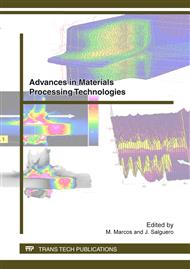p.97
p.103
p.109
p.115
p.121
p.127
p.133
p.139
p.145
Force and Deformation Model for Error Correction in Boring Operations
Abstract:
Boring operations of deep holes with a slender boring bar are often hindered by the precision because of their low static stiffness and high deformations. Because of that, it is not possible to remove much larger depths of cuts than the nose radius of the tool, unlike the case of turning and face milling operations, and consequently, the relationship between the cutting force distribution, tool geometry, feed rate and depth of cut becomes non-linear and complex. This problem gets worse when working with a rotating boring head where apart from the cutting forces and the variation of the inclination angle because of shape boring, the bar and head are affected by de centrifugal forces. The centrifugal forces, and therefore the centrifugal deflection, will vary as a function of the rotating speed, boring bar mass distribution and variable radial position of the bar in shape boring. Taking in to account all this effects, a load and deformation model was created. This model has been experimentally validated to use as a corrector factor of the radial position of the U axis in the boring head.
Info:
Periodical:
Pages:
121-126
Citation:
Online since:
April 2012
Authors:
Keywords:
Price:
Сopyright:
© 2012 Trans Tech Publications Ltd. All Rights Reserved
Share:
Citation:


